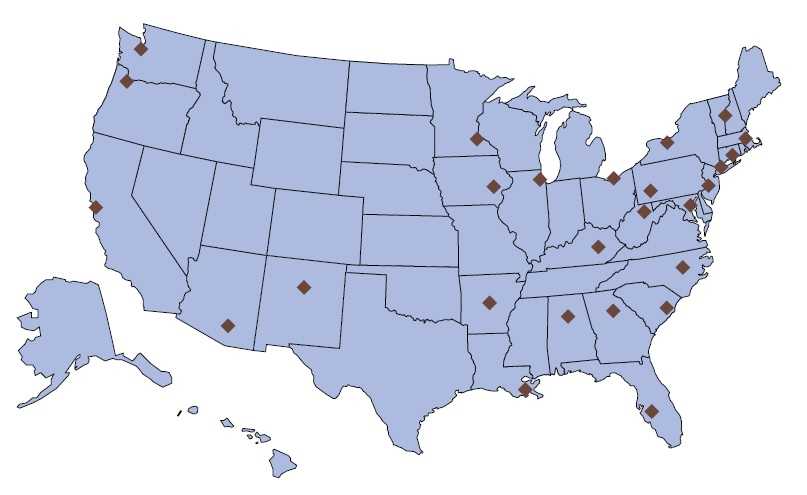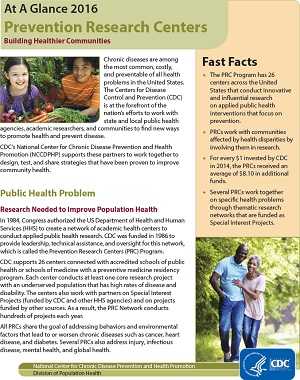Prevention Research Centers
Building Healthier Communities
At A Glance 2016
Chronic diseases are among the most common, costly, and preventable of all health problems in the United States. The Centers for Disease Control and Prevention (CDC) is at the forefront of the nation’s efforts to work with state and local public health agencies, academic researchers, and communities to find new ways to promote health and prevent disease.
CDC’s National Center for Chronic Disease Prevention and Health Promotion (NCCDPHP) supports these partners to work together to design, test, and share strategies that have been proven to improve community health.
Public Health Problem
Research Needed to Improve Population Health
In 1984, Congress authorized the US Department of Health and Human Services (HHS) to create a network of academic health centers to conduct applied public health research. CDC was funded in 1986 to provide leadership, technical assistance, and oversight for this network, which is called the Prevention Research Centers (PRC) Program.
CDC supports 26 centers connected with accredited schools of public health or schools of medicine with a preventive medicine residency program. Each center conducts at least one core research project with an underserved population that has high rates of disease and disability. The centers also work with partners on Special Interest Projects (funded by CDC and other HHS agencies) and on projects funded by other sources. As a result, the PRC Network conducts hundreds of projects each year.
All PRCs share the goal of addressing behaviors and environmental factors that lead to or worsen chronic diseases such as cancer, heart disease, and diabetes. Several PRCs also address injury, infectious disease, mental health, and global health.
Each center conducts academic research with community partners. Through scientific rigor, collaborative partnerships, and practical application, PRCs continue to find new ways to improve quality of life across the nation. For every $1 invested by the PRC Program in 2014, the PRCs received an average of $8.10 in additional funds.
CDC’s Response
NCCDPHP works in four key areas or domains: epidemiology and surveillance, environmental approaches, health care system interventions, and community programs linked to clinical services. This comprehensive approach supports healthy choices and behaviors, makes healthier options more available, and helps Americans better manage their health.
CDC is committed to leading strategic public health efforts to prevent chronic conditions and to end health disparities. With $25 million in FY 2016 funding, the PRCs will conduct work in all four of NCCDPHP’s domains. CDC also awarded 65 Special Interest Projects to 22 PRCs with FY 2015 (Year 2) funding to design, test, and share effective prevention research strategies for public health.
Epidemiology and Surveillance
Deaf and hearing researchers and community members from the University of Rochester PRC created the Deaf Health Survey, a video survey of health risk behaviors among deaf adults who use American Sign Language. Because national health surveys are not conducted in sign language, little is known about the health risk behaviors of deaf adults. The survey produced the first health surveillance data from deaf adults in Rochester, New York.
Environmental Approaches
The Tulane University PRC addresses aspects of the physical and social environment that influence diet and physical activity in New Orleans. The PRC supported coordination of the Healthy Food Retail Study Group and the development of recommendations for improving residents’ access to healthy foods. The recommendations were used to develop the Louisiana Healthy Foods Retail Program, which gives grants and loans to supermarkets, farmers’ markets, and food retailers to make fresh fruits, vegetables, and other healthy foods affordable in low-income communities.
Related Materials
Fast Facts
- The PRC Program has 26 centers across the United States that conduct innovative and influential research on applied public health interventions that focus on prevention.
- PRCs work with communities affected by health disparities by involving them in research.
- For every $1 invested by CDC in 2014, the PRCs received an average of $8.10 in additional funds.
- Several PRCs work together on specific health problems through thematic research networks that are funded as Special Interest Projects.

Health Care System Interventions
 Researchers from the University of Kentucky PRC developed and piloted a DVD titled 1-2-3 Pap that encourages rural Appalachian women to complete the human papillomavirus vaccine series, a primary strategy to prevent cervical cancer. Women who watched the DVD were more than twice as likely to complete the series as women who received standard care. The PRC worked with its partners to adapt this intervention so it could be repeated in other underserved areas with high rates of cervical cancer.
Researchers from the University of Kentucky PRC developed and piloted a DVD titled 1-2-3 Pap that encourages rural Appalachian women to complete the human papillomavirus vaccine series, a primary strategy to prevent cervical cancer. Women who watched the DVD were more than twice as likely to complete the series as women who received standard care. The PRC worked with its partners to adapt this intervention so it could be repeated in other underserved areas with high rates of cervical cancer.
Community Programs Linked to Clinical Services
At the University of Arizona PRC (AzPRC), researchers are identifying guidelines for primary care best practices for community health workers (CHWs) that address chronic disease and mental health. The AzPRC is also helping to develop an effective CHW program model that links primary care settings with community health services.
An evaluation of a prevention program called Pasos Adelente (Steps Forward) found that CHWs were effective in motivating Latino adults to reduce their risk of heart disease, diabetes, and other chronic diseases related to diet and physical activity. Improvements were reported in participants’ body mass index, blood pressure, total cholesterol, and glucose levels.
Networking for Knowledge
Groups of PRCs work together in thematic networks that address research gaps in cancer prevention and control, cognitive health, global health, physical activity policy, epilepsy management, nutrition and obesity policy, and workplace health. The variety of centers and community partners allows researchers to test strategies in many kinds of settings at the same time.
The PRCs also work closely with health departments, the private sector, education agencies, and national and community organizations. These partnerships help translate promising research findings into practical, cost-effective prevention programs that are relevant to the needs of the community.
Future Directions
PRCs will continue to collaborate with health departments and other public health partners to translate promising research findings into practical, cost-effective prevention programs.
CDC will continue supporting the seven thematic networks: Cancer Prevention and Control Research Network, Global and Territorial Health Research Network, Healthy Brain Research Network, Managing Epilepsy Well Network, Nutrition and Obesity Policy Research and Evaluation Network, Physical Activity Policy Research Network Plus, and Workplace Health Research Network.
During 2014-2019, each PRC will conduct a research project in one of the following categories: dissemination and implementation research, public health practice-based research, or intervention research.
CDC’s Network of Prevention Research Centers,* 2014-2019

*Note: A list of the 26 centers and their core projects is provided below.
Prevention Research Centers: Core Projects, 2014-2019
University of Alabama at Birmingham
Preventing HIV/AIDS among at-risk African American adolescents living in disadvantaged neighborhoods.
University of Arizona
Strengthening prevention programs and links between primary care settings and county health departments.
University of Arkansas for Medical Sciences
Improving control of high blood pressure by identifying effective and cost-effective methods.
University of California, San Francisco
Improving care of black men living with HIV through community engagement and support.
Case Western Reserve University
Improving access to nutritious food in low-income, low-access neighborhoods through farmers’ markets and education.
Dartmouth College
Reducing obesity and smoking among people with serious mental illness.
University of Illinois at Chicago
Increasing physical activity by improving access to the built environment and use of parks in the community.
University of Iowa
Increasing physical activity in communities by using lay health advisors.
Johns Hopkins University
Preventing substance abuse through life skills training for adolescents.
University of Kentucky
Increasing colorectal cancer screening among adults in rural Appalachia.
University of Massachusetts Medical School-Worcester
Improving healthy eating and healthy activities with a built environment intervention.
University of Minnesota
Improving learning and academic performance and reducing health risk behaviors among middle school students and improving teacher skills.
Morehouse School of Medicine
Preventing HIV/AIDS and other sexually transmitted diseases among minority youth in urban areas.
University of New Mexico Health Sciences Center
Promoting healthy eating, active living, and tobacco-free living.
New York University School of Medicine and City University of New York School of Public Health
Improving management of high blood pressure among South Asians in New York City.
University of North Carolina at Chapel Hill
Preventing heart disease through community programs linked to clinical services.
Oregon Health & Science University
Using health promotion and chronic disease prevention to meet the health needs of tribal and other underserved regional communities.
University of Pennsylvania
Promoting weight loss and maintenance in the workplace through behavioral economics and environmental change strategies.
University of Pittsburgh
Reducing obesity and subsequent chronic disease among older adults.
University of Rochester
Increasing healthy lifestyles among deaf adults who use sign language.
University of South Carolina at Columbia
Increasing physical activity and healthy eating in churches in South Carolina.
University of South Florida
Increasing colorectal cancer screening among adults in partnership with the health department.
Tulane University
Increasing physical activity and healthy eating by improving physical and social environments.
University of Washington
Increasing participation of older adults in a community exercise program (EnhanceFitness) through community programs linked to clinical services.
West Virginia University
Improving physical activity behaviors among children through school- and family-based approaches.
Yale University
Reducing obesity through improved nutrition and increased physical activity in multiple communities.
- Page last reviewed: May 18, 2016
- Page last updated: May 18, 2016
- Content source:



 ShareCompartir
ShareCompartir
